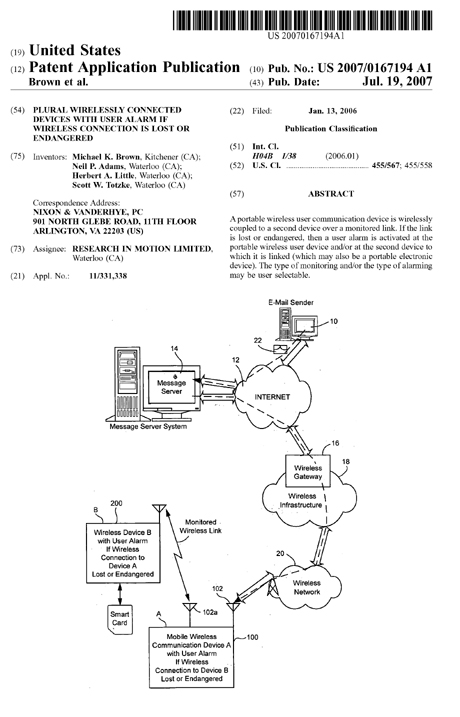BlackBerry Patent app describes tethered BlackBerry user alarms

A newly published BlackBerry Patent application describes technology that would wirelessly tether one BlackBerry to another- and would devise a way for the first BlackBerry to "alert" the second if it is disabled somehow.
The Patent application is entitled, Plural wirelessly connected devices with user alarm if wireless connection is lost or endangered.
Ordinarily I would reproduce the Abstract here. However, in reading this Patent Application, a more thorough and plainly written explanation of how this technology works is in the Patent literature itself.
So let's go there.
We now provide a user alarm if a wireless connection between related devices is lost or endangered.
For example, if one is using a smart card reader with a portable wireless communication device for access control, if the smart card reader and the wireless communication device are separated beyond usable wireless link range, then the wireless communication device will lock up.
However, as a user, it would be a great improvement to know about this when it happens so that the situation can be rectified (or perhaps even prevented if a warning signal is given in advance of actual link loss).
For example, if one forgetfully leaves the smart card reader in a restaurant, a user alarm can provide immediate notification that the smart card reader was forgotten while it is still convenient and timely to go back and retrieve it from the restaurant. This is considerably better than perhaps discovering an hour or so later that the wireless communication device is locked when one next goes to use it.
In the exemplary embodiment, a wireless communication device (and quite possibly the smart card reader itself) monitors a Bluetooth wireless connection with a smart card reader access control device.
If it is determined that the connection has been broken (or is endangered), then the user is notified with an attention-getting alarm. For example, an audible beep or ringtone may be used to audibly alert the user or tactile senses may be used via a vibrator output or other types of alarms such as a visual alarm like a flashing LED or LCD might be used.
Preferably, the type of alarming notification may be selectively controlled by the user who may be given an option (e.g., via an existing user profile application) to specify the desired type of alarm notification.
The type of notification could even be automatically changed in response to sensed changes in a current user profile (e.g., if the user selects a vibrator output for incoming message notifications, then a vibrator alarm output could also be automatically chosen).
In addition, if the security device (e.g., smart card reader) is outfitted with sufficient hardware (e.g., an audible speaker, tactile vibrator or flashing light), it could also be programmed to provide an alarm notification to the user such that if the situation is reversed (e.g., the wireless communication device is forgetfully left at the restaurant), then the user could also receive an alarm notification to permit quick and convenient rectification of the situation.
There are a number of wireless link monitoring techniques that may be employed. To enhance security features, if a cryptographically secure "heartbeat" is available on the link, then such a "secure" heartbeat may be monitored and one or a number of missing secure heartbeats would then be interpreted as a broken or endangered link such as to generate a suitable alarm.
If a secure heartbeat signal is not present (or if for some reason it is not desired to monitor the secure heartbeat), then typically another non-secure (possibly low level, infrequently occurring) link heartbeat may be monitored to ascertain continued viability of the wireless link. Still further, or alternatively, signal power on the link may be monitored so as to detect when it passes below one or more thresholds indicating that the link is either endangered or no longer useful (i.e., broken).
In exemplary embodiments herein described, the user is given an attention-getting signal (e.g., audible, tactile or visual) that is not likely to be ignored or unnoticed when the two wirelessly-connected devices lose their connection (or the connection is endangered). In one exemplary embodiment, both devices connected by the monitored wireless link are portable. However, it is also possible that our alarming techniques could be utilized to monitor wireless communication links between one or more portable devices and one or more non-portable devices.
The described embodiments may be realized in hardware, software or a combination of hardware and software and provide a method for monitoring a wireless connection between plural devices and generating a user alarm if the wireless connection is lost or endangered. The exemplary embodiments are realized, at least in part, by executable computer program code which may be embodied in physical digital memory media.
